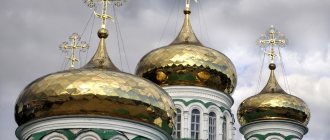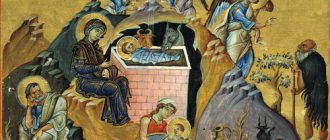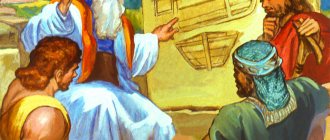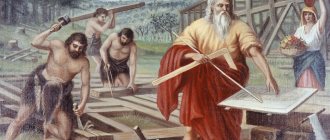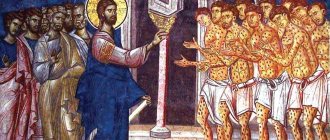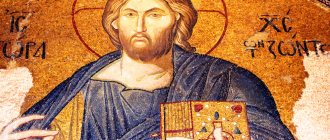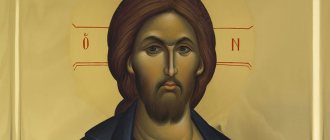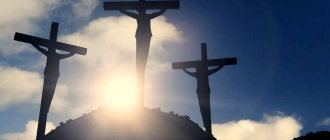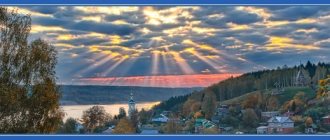This parable is about readiness to bear the fruits of true faith.
Parables always have several meanings: everyday (everyday), professional - on the one hand, and religious (philosophical), spiritual (moral), historical - on the other hand.
And he spoke this parable: A man had a fig tree planted in his vineyard, and he came looking for fruit on it, and found none; and he said to the vinedresser: “Behold, I have come for the third year looking for fruit on this fig tree and have not found it; cut it down: why does it occupy the land?” But he answered him: “Sir! leave it this year too, while I dig it up and cover it with manure, and see if it bears fruit; if not, then next year you will cut it down.” (Luke 13:6-9)
First of all, what kind of tree is a fig tree? This is a tree whose fruit is figs.
Everyday aspect
A person (let it be a resident of our city) has a garden or vegetable garden. There he grows cucumbers, zucchini, tomatoes, cherries, plums, and apples. There is not enough land for a garden; you can’t turn around on our Soviet six hundred square meters. A lot of work has been put in. It is necessary to weed, water, remove weeds, protect from pests. You go out into the garden to eat currants, and you see the following picture: in the center of the garden there is an old apple tree and you understand that there will be no apples again this year. The tree's root system is already large. The tree takes a lot of nutrients. There are worries that there will be few cucumbers and small tomatoes. The crown of the apple tree is large - the sun blocks the plum tree. It's a simple problem. What thoughts do you have? Similar to the thoughts of the owner of the vineyard. It is necessary to cut down so that younger crops will bear more fruit. And you have already made up your mind. The saw and shovel are ready. But someone suddenly says: “Let me dig it up, fill the root system with air, cover it with manure - maybe it will yield a harvest next summer.”
Your choice? Definitely cut it down next year, and this year, thanks to your volunteer, you will leave it. Because you want to see your garden perfect. Next year, any decision will be correct.
The everyday aspect is simple: do as you decide, but don’t rush. We do exactly the same in other cases. The car broke down; The breakdown is the same, repeated. What to do? Well, I’ll thoroughly repair it again, and if it happens again, I’ll sell it for parts. I'll buy another inexpensive one, but a good one.
NEW TESTAMENT – FIG TREE – TORAH
New Testament – Fig Tree – Torah
What is the connection of this tree with the Biblical story about how Jesus cursed this tree?
Many are perplexed why Jesus dried up (cursed) the tree when it was not bearing fruit? So, in order to understand this act of the Messiah and understand what He wanted to tell us by this, we need to delve into history and into the Jewish teachings that Jesus (Yeshua) knew by heart, since from the age of 12 he preached in Synagogues (Jewish temples) and The Jews marveled at His abilities. About the tree:
This tree is not just ancient, it is from the Creation of the World.
When Eve (Hava) and Adam disobeyed the Creator’s commandments and tasted forbidden knowledge, they were ashamed and covered themselves with the leaves of the Fig tree. Figa or Fig Tree is another name for the Fig Tree (it has nothing to do with the Russian folk fig). This tree is also called Fig or Wineberry or Carian ficus. The fig tree is a subtropical deciduous plant of the genus Ficus of the Mulberry family. The tree is “green” all year round, and the leaves partially fall off (renewing the tree). Depending on the growing region, the leaves may fall off completely (for some time) and the fruits may hang on the tree without leaves. Therefore, since ancient times it has been believed that fruit can be found on the Fig tree all year round
.
The trees are pollinated by special insects, black wasps - Blastophagous
(Chalcidian wasps).
These wasps themselves cannot reproduce without Fig trees and feed on it,
such a symbiosis. Nowadays, there are artificially bred bisexual Fig (Fig) trees that have female and male trees (the pollen is also carried by insects).
About Torah:
The Jewish Torah (Law) is the original name of the five books of Moses.
Later in the new era, with the advent of the New Testament, it acquired the name Old Testament. The Jewish Tanakh, in the likeness of the Bible (a collection of Jewish canonical books) which includes the five books of Moses, the Prophets and the Scriptures, and 24 books (or 27). There are also seventy secret books
that God has ordered to be hidden from the unprepared, but only for the wise.
The Torah is still symbolized in Judaism by the Fig tree, as the tree of wisdom!
The founders of Jewish theological teachings poetically compared the Torah to the Fig Tree.
Thus, Rabbi Yochanan describes his life experience; “and I ran to the east side of the fig tree (the sweetest fruits are on the east side), and what Ecclesiastes said happened to me - wisdom gives life to the one who owns it,” or; “He who guards the fig tree will eat its fruit,” or; “Just as a fig tree, whenever a person touches it, there is fruit on it, so the words of the Torah - whenever a person pronounces them, there is meaning in them.” The fruit of the fig tree ripens at different times of the year, and the Talmud indicates that seasonal workers are not hired to pick figs, and Jewish law does not require that part of the fig tree be left for the poor. No accounting or control over the fruits of this tree is possible, and the same is true in relations with this “willful” tree. The owner is connected with his fig tree by a special, personal, sacred relationship that does not allow interference from outsiders. The owner of the Fig tree must himself approach the tree, touch it, and the fig tree, as if responding to his care, as if of its own free will, gives him its fruits (wisdom). And the same relationship connects a Jew with his Torah. About the New Testament:
Well, only now we will analyze and be able to understand the events from the New Testament concerning the very Fig tree that Jesus Christ cursed and it dried up.
But first, let us remember the statement of Christ in his address to the Jews from (Holy Gospel of John 8:43,44)
Why do you not understand My speech? Because you cannot hear My (true) word. Your father is the devil, and you want to do the lusts of your father. He was a murderer from the beginning and did not stand in the truth, for there is no truth in him. When he tells a lie, he speaks his own way, for he is a liar and the father of lies.
Now let’s read the very events with the Fig tree: (Holy Gospel of Mark 11:12-14)
The next day, when they left Bethany, He became hungry;
and seeing from afar a fig tree covered with leaves, he went to see if he could find anything on it; but when he came to her, he found nothing but leaves, for it was not yet time to gather figs. And Jesus said to her: From now on let no one eat fruit from you forever!
And His disciples heard it.
And further
we read:
(Holy Gospel of Matthew 21:18-20)
In the morning, returning to the city, he became hungry;
and seeing a fig tree along the road, he approached it and, finding nothing on it except some leaves, said to it: Let there be no fruit from you henceforth forever.
And the fig tree immediately withered. Seeing this, the disciples were surprised and said: How did the fig tree immediately wither?
(Holy Gospel of Matthew 21:42,43)
Jesus says to them: Have you never read in the Scripture: Therefore I say to you, that
the kingdom of God will be taken away from you and given to a people producing the fruits thereof
...
Thus, we become witnesses when Christ cursed the Old Testament and human wisdom in Him, with the words: And let there be no fruit from you henceforth forever! From now on, let no one eat fruit from you forever!
Then followed the events that marked the New Testament, the New Teaching, the New Time and the New Era. There were many leaves on the Fig tree, but no fruit. There are many words and rules, but no fruits of the Holy Spirit.
Brief research paper by S.I. dated February 3, 2022, Kursk city. ( With verbosity
sin
cannot be avoided , but he who restrains his lips is wise. Book of Proverbs 10:19)
Religious aspect
The fig tree is a symbol of Israel, its well-being and prosperity. Figs saturate the body very quickly. It is very nutritious. Warriors stocked up on it, it took up little space and quickly restored strength. The fig tree in this parable signifies the religious community of Israel, and indeed the entire Jewish people. What fruits did the owner (obviously this is God) expect to see from the Ancient Jews? The fruits of repentance, the fruits of good deeds, the fruits of faith, any fruits that glorify His greatness and His loving nature.
The fig tree bears fruit in a very interesting way. While other fruit trees first produce flowers and only then set fruit, the fig tree first produces flowers, then flowers, and only then develops fruit.
Therefore, despite all the beauty of this tree and its healthy appearance, already in the early stages of fruit ripening you can understand whether there will be a harvest or not.
It soon became clear to God (Christ), who came 20 centuries ago to the Jewish people to restore people’s relationship with God, that there would be no fruits of repentance. People are not looking for God. What are they busy with?
- political situation (Israel was under the union of Rome),
- philosophical teachings,
- everyday problems (70% live below the poverty line).
The nobility is money-loving. Jews from philosophical schools (Pharisees and Saducees) boasted of external observance of traditions, knowledge of the law, reading psalms, going to temple and other religious actions, but their hearts moved further and further away from God.
The people saved on everything and stopped giving God the most valuable things; They put into the tithe the lame and the blind and the corrupt; they stopped keeping their hearts pure. But the memory of the great religious past was in them. Therefore, every time the Pharisees, scribes and spiritual nobility tried to testify to outsiders their holiness with public prayers and fasts, and commoners - by stoning harlots and adulterers.
The Jews perverted the commandments of the Lord. Nevertheless, Jesus was with the people for three years, performed many miracles, taught in synagogues, in squares, in houses, on highlands (so that everyone could see and hear), seeking the fruits of faith. But I didn’t find it. Where did he find it? In the Samaritans! The people who lived next door were also once Jews, but they allowed their blood to mix with other peoples. The Samaritans were considered an unclean people. Remember the parable of the Good Samaritan? Do you remember the Samaritan woman who asked for the recovery of her daughter and to whom Jesus said: “It is not good to take the children’s bread and throw it to the dogs?” And she answered: “But dogs eat the crumbs that fall from the owners’ table.” Such faith could not help but touch the heart of Christ. Although, I am sure, he wanted to see such fruits of faith in Israel.
It must be said that the entire history of the relationship between God and man is closely connected with bearing fruit for God. What fruits please God?
Remember the fruits of the Spirit?
The fruit of the Spirit is love, joy, peace, long-suffering, kindness, goodness, faith, meekness, self-control. There is no law against them. (Galatians 5:22)
In other words, actions that cannot be described by any instructions. Where do these fruits grow? In heart!
And then, so to speak, a year passes and the fig tree that was dug up again did not bear fruit. The time has come to make a decision and give other crops (peoples) a chance to bear fruit abundantly.
In the morning, returning to the city, he became hungry; and seeing a fig tree along the road, he approached it and, finding nothing on it except some leaves, said to it: Let there be no fruit from you henceforth forever. And the fig tree immediately withered. (Matthew 21:18-22)
These events happened after Jesus entered Jerusalem on a donkey. At this moment, the common people greeted him as the King of Israel and thanked him for his healings and resurrection of the dead. And they associated with it changes in the political life of Israel (liberation from Roman subjugation); after the expulsion of the money changers and merchants from the temple; after a series of more healings.
Yet Jesus saw a different picture. The crowd, which greeted him as a King, three days later will demand that Pilate crucify Christ because He, obviously, did not become their people's state leader (leader) and did not live up to their internal expectations. But Varrava tried, for which he was pardoned. Jesus did not preach earthly liberation, but spiritual liberation. And He is not an earthly king, but a Heavenly one.
The Israelites and Jews failed to understand this and change their hearts.
They were unable to bear fruits worthy of repentance. Who are these new cultures/peoples? These are the ones who seek God. Chosen not according to flesh and blood, but according to the spirit. It is you and me - the pagans, to whom the door to the Kingdom of Heaven has also been opened.
Miracle of destruction. Why did Christ curse the fig tree?
Estimated reading time: 6 minutes.
This happened a few days before the execution on Calvary. Jesus spent the last week of his earthly life in Jerusalem with his disciples. In the evening he went to spend the night in the suburbs - on the Mount of Olives. This is what the Gospel says: “In the morning, returning to the city, he became hungry. And seeing a fig tree along the road, he approached it and, finding nothing on it except leaves, said to it: Let there be no fruit from you henceforth forever. And the fig tree immediately withered” (Matthew 21:8-19). Evangelist Mark supplements Matthew with a striking detail: Jesus approached the tree, although “it was not yet time to gather figs” (Mark 11:13). At first glance, it seems that Christ punished the tree for nothing - after all, it is not to blame for the lack of fruit. Moreover, what’s the point of looking for fruits on it if it’s not the season? Was this simply done out of irritation, out of frustration?
The fig tree is a fruit tree, better known to us as the fig. The homeland of the fig tree is Asia Minor and the Mediterranean. The tree reaches 11 meters in height, although on rocky soils it often grows as a shrub. According to the Bible, after the Fall, Adam and Eve made their clothing from fig leaves (Gen. 3:7). In the symbolism of the Old Testament, the fig tree is an image of peace and Divine favor.
To understand any passage in the Bible, you need to know the context. Does anyone else talk about fig trees? Yes, there are such places. About six months earlier, Christ told the following parable: “A man had a fig tree planted in his vineyard; and came to look for fruit on it, and did not find it. And he said to the vinedresser: “Behold, for the third year I have come looking for fruit on this fig tree, and I have not found it; cut it down: what does it occupy the land for?” But he answered him: “Sir! leave it this year too, until I dig it up and cover it with manure: will it bear fruit? if not, then next year you will cut it down” (Luke 13:6-9).
Jesus often used parables in His preaching, especially when speaking to the common people. How could it be otherwise possible to reveal to people the greatest secrets of the spiritual world, without relying on everyday realities understandable to everyone? Moreover, these realities often served as religious symbols for the Jews. The vineyard and fig tree were understood not only as agricultural crops. In the Old Testament, Israel is called the “vineyard of the Lord” and the “fig tree.” This tree also symbolized peace and God's blessing to the people of Israel. Most interpreters of the Gospel believe that this parable implies a kind of dialogue between the Persons of the Holy Trinity - God the Father (the owner of the vineyard) and the incarnate Son of God (the vinedresser) about the fate of Old Testament Israel, represented in the image of a fig tree. For three years the fig tree (Israel) could not bear fruit. Why exactly three years? This is how long Jesus preached to the Israelites before he told this parable.
What fruit was the “fig tree” supposed to bear? The core of the Old Testament is the preparation of people to meet the Messiah, who would deliver Israel from sin. However, by the time Jesus preached, this deliverance was often understood in a very simplified way. Not as deliverance from the power of sin, but as the achievement of political independence from the Roman Empire, that is, deliverance from the power of the pagans. Therefore, most of the religious leaders of Judea did not recognize and did not accept the One for whom they themselves, and their fathers and grandfathers had been waiting for so long... A repentant turn to God and faith in salvation through the God-man, Jesus Christ - this is the fruit that the Lord was waiting for from the Jews. And first of all - from their leaders and teachers.
So, Jesus asks the Father to wait a little and not cut down the barren plant. After this, Christ’s ministry continued for another six months, and all this time, as before, He “fertilized,” “dug in,” and “cultivated” the petrified human hearts—wouldn’t they bear fruit? And now, on the threshold of suffering on the cross, seeing the stubborn unbelief of the leaders of Israel, Christ pronounces judgment.
But the form of the trial was again figurative, parable, only this time the parable sounded not in words, but in actions. But which ones? Jesus did not burn the disbelieving Jews with fire, did not turn them into pillars of salt - but by drying up the fig tree, he showed them their prospects, unless, of course, they repent. And he did it in such a way that the effect of the curse became an obvious fact, and not just a strict word. This warning became a reality only forty years later, in the year 70. Emperor Vespasian then drowned the uprising of the Jews in blood, almost completely destroyed Jerusalem, the Temple of Jerusalem, and even destroyed the nominal statehood of the Jews. Therefore, Christ’s warning was so strong not because of irritation and anger, but because the Lord really wanted to prevent the impending tragedy.
The curse of the barren fig tree is a parable in action. This has already happened in the history of Israel; the Hebrew prophets used this form of preaching. Jeremiah, in front of the people, placed bonds and a yoke around his neck and sent the same bonds to the kings of other nations - as a sign that they would all serve the Babylonian king Nebuchadnezzar (book of the prophet Jeremiah, chapter 27). Ezekiel placed a brick in front of him, which symbolized Jerusalem, and led a siege against it, thereby showing the Jews that the city would be besieged by the Babylonian king. He, according to the word of the Lord, publicly prepared for the journey, made a hole in the wall and carried out his belongings through it, thereby depicting that after the capture of Jerusalem by Nebuchadnezzar, the people of God would be resettled into captivity (book of the prophet Ezekiel, chapters 4 and 12).
But still, something remains unclear in the parable. Why did Jesus even approach the tree if the time for fruiting had not yet arrived? The fact is that the fig tree (we are more familiar with the name fig) has a characteristic feature. The fruits appear on it before the leaves, and then ripen. Then, in the spring, the rest of the trees stood still naked, and the fig tree was covered with leaves. It would be logical to expect fruits, but...
Interpreters of the Gospel compare this barren fig tree with the Israel of Christ today. When the Lord approached the tree, only it, unlike other fig trees, was covered with leaves. Likewise, among all the peoples of the ancient world, only the Israelites had a revealed religion, the Law and prophets - that is, they knew what fruit the Lord expected from them. And if for the rest of the nations the time of fruiting had not yet come, the news of salvation through the God-man Jesus Christ had not yet spread throughout the world, then Israel had to bear fruit, had to recognize in Jesus its long-awaited Messiah.
Approaching the fig tree, Christ did not find any fruit on it - it was simply misleading, deceiving the traveler with its beauty, but was absolutely useless because it could not satisfy his hunger. So Christ “came to his own, and his own did not receive him” (John 1:11). Beautiful and magnificent services continued to be held in the Jerusalem Temple, and the blood of sacrificial animals flowed in streams. But after the coming to earth of the God-Man, after His sacrifice on the cross, these rituals became absolutely useless for those who thirsted to satisfy the hunger of God-forsakenness. Indeed, if Jesus is God, then no sacrificial rams are needed.
Historically, the curse of the fig tree is a symbol of Christ's rejection of those religious leaders of Judea who rejected Him. But the Holy Scriptures are not an archive of miracles and highly moral sermons, nor a museum of curses and blessings. Everything that the Gospel Christ did, He continues to do to this day - to love those whom no one loves, to forgive those from whom everyone has turned their backs, to heal people from mental and physical ailments, about whom they say that they are doomed... But, like two thousands of years ago, sometimes He encounters barren fig trees on His way. Only now they are covered with leaves not of the Old Testament, but of the New Testament commandments. Commandments that were formally learned and did not change the human heart... Therefore, the Gospel story about Christ’s curse of the barren fig tree serves as an ahistorical and timeless reminder to all generations of Christians that anyone can find themselves in the place of a barren plant.
Author of the drawings: Vera Makhankova.
Moral aspect
Our God (Christ) is patient. And he waits for His word to enter our hearts, sprout and bear fruit in due time. He not only wants to see us in eternity, He wants us to grow in the knowledge of the truths of God and bear fruit abundantly. What fruits can we bear today: stop deceiving, stop being angry and hating; be vulnerable to criticism; try to get along with your spouse, with a colleague at work; visit parents, maybe one of the sick or infirm; fulfill promises. Share the burden of labor with someone. Maybe take part in some charity event. And this is not difficult, it is much more difficult to forgive grievances, debts, betrayal, technical, medical and legal errors - these are, perhaps, the rarest fruits.
But God is looking for them too. It is difficult to comment on such mistakes, but I have living evidence from one of my friends, a patient with a severe form of cerebral palsy, who received his illness in the first hours of his life due to the careless actions of staff. But this man did not become embittered. I have never seen so many friends involved in communication with a patient who is deprived of the ability to move independently. He even managed to visit different places in our country. God gave him joy and peace. Such fruits ripen where there is incredible vitality, love of life, a calm positive outlook on any events; where the realization comes that God has forgiven us the insults of others, and our debts to others (remember Our Father: and forgive us our sins, for we also forgive every debtor), and our betrayal, and our professional and everyday mistakes, because which others suffered.
About the barren fig tree
In the name of the Father, and the Son, and the Holy Spirit!
Curse of the fig tree. Book miniature from the Arabic Gospel of the 17th century.
On today’s Great Monday, according to the church calendar, we remember how the Lord expelled traders from the Jerusalem Temple and cursed the barren fig tree.
These events, the actions of Christ, seem incomprehensible at first glance, causing confusion and misunderstanding. Why was the fig tree cursed if Jesus came to it when it was not yet time to gather figs?
(Mark 11:13)? But such actions of the Savior, such as cursing the fig tree, turn out to be full of symbolic and spiritual meaning if you look closely at the details.
After his triumphal entry into Jerusalem, Christ spent the night with His disciples in Bethany. In the morning, going to the temple, He became hungry along the way. To satisfy His human needs, Christ never used Divine power, but resorted to human means, rejecting the devil’s temptation to create bread from stones.
When a fig tree covered with leaves appeared in the distance, Christ approached it like a man. The loose leaves of the tree suggested that there would be fruit on the fig tree, because the fig tree produces fruit first and then leaves. Since the time for picking figs had not yet come (see: Mark 11:13) and the early fruits had not yet been picked, one could expect that at least unripe ones would be found on the green fig tree. However, coming closer, the Lord discovered that there were neither green nor last year’s fruits on it. This means that a tree that was untimely covered with leaves was completely barren.
The Monk Ephraim the Syrian is surprised at this: “Why did this sweet Benefactor, Who everywhere showed much in small things and fullness in shortcomings, commanded the fig tree to wither? He healed all human diseases, turned water into wine, made many from a few loaves, opened the eyes of the blind, cleansed lepers and raised the dead to life; He directly commanded only one fig tree to wither..."
And Saint Ephraim himself answers: Christ performed many miracles, but was still crucified. Because of this, some might suspect that His strength was exhausted. To prevent this with the help of a soulless plant, which He dried up, He showed that through the word He could also destroy His crucifiers. As he later said to Simon Peter: Return your sword to its place.
, I can ask the Father, and
He will present to Me more than twelve legions of Angels
(Matthew 26: 52–53). This means that Christ, as a man, was hungry, but as God, He demonstrated His power on the fig tree.
Seeing the unusual miracle, His disciples were surprised: Lord, look, the fig tree that You cursed has dried up.
(Mark 11:21).
To this Jesus said: Have faith in God;
whoever does not doubt in his heart and says to the mountain: “Cast yourself into the sea,” his words will come true (Mark 11:23).
This “moving of a mountain” is an example that for faith free from doubt, nothing is impossible. Therefore, in prayer you must ask for everything with faith in order to receive. But, as Evangelist Mark notes, the condition for the effectiveness of prayer is the forgiveness of the sins of your neighbors: if you do not forgive, then your Heavenly Father will not forgive you your sins
(Mark 11:26). The Lord’s words and deeds did not differ, so we can assume that He cursed the fig tree “not out of malice.” He forgave the Jews who crucified Him. And, therefore, the drying up of the fig tree was an exclusively symbolic matter - as a sign of the Divine power of Christ, the Son of God.
Curse of the Fig Tree
One more question can be asked: why did the fig tree and fig tree become the tree of the curse?
According to the Old Testament, healing powers were attributed to figs; in particular, it was believed that a “layer of figs” healed abscesses (see: Is. 38: 21). The fig tree was one of the seven plants and products symbolizing the wealth of the promised land (see: Deut. 8:8). Fig trees were planted in vineyards (see: Luke 13:6) so that the vine would twine around the tree trunk. The expression “to live under the vineyard and fig tree” allegorically meant peace and prosperity (see: 1 Kings 4:25; 2 Kings 18:31; Micah 4:4; Zech. 3:10).
But in addition to its natural properties, the fig tree also had a symbolic meaning. For the teachers of Israel, the rabbis, she became a symbol of wisdom. One of the treatises of the Talmud recorded the following statement by Rabbi Yochanan: “Like a fig tree, whenever a person touches it, there is fruit on it; so are the words of the Torah - whenever a person pronounces them, there is meaning in them” (Eruvin 54 a, b). The Jewish sage promises fruits from the law of Moses - “at all times.” This seems to be a kind of maximalism, because in winter the fig tree does not produce fruit. When Christ came to a certain promising fig tree in April to look for fruit, He found nothing. Symbolically, He did not find that good fruit that the rabbis promised “at all times.” And in contrast to their claims to maximum wisdom, the Lord declared: “ Let there be no fruit from you forever. ”
"(Matthew 21:19).
Fig tree immediately
dried up to the roots (see: Matt. 21:20; Mark 11:20). A concrete miracle took place, obvious to others. But at the same time, a symbolic and educational miracle also happened.
Six months before His saving suffering, the Lord uttered the parable of the barren fig tree (see: Luke 13: 6-9): that a certain vineyard owner had been looking for fruit for three years, but not finding it, he decided to cut down the barren tree. The owner’s only winegrower begged him: “Leave the fig tree for one more year,” I will dig up and fertilize it. If even after this it does not bear fruit, then you will cut it down.
Exactly six months after the utterance of this parable, a few days before the Jewish Passover, the time of waiting for God expired. Almost four years of the Savior’s ministry have passed, during which He abundantly watered the soil of human hearts with the “living water” of His preaching. But the fig tree of the Jews remained barren. And since the wood of the fig tree is not suitable for any building needs, such a tree, which does not bear good fruit, is cut down and thrown into the fire
(Matt. 3:10; 7:19; Luke 3:9).
We cannot help but be surprised that the Lord came to do only good and improve everything, but He commits destructive actions at least three times. And this is not just like that. He drowned a herd of pigs so that the unbelieving inhabitants of the Gadarene country would come to meet Him at least through material losses. He opened the tombs of the departed saints, so that after Christ’s death on the Cross they would come out of their tombs and appear to many (see: Matt. 27: 52–53). He also withered the fig tree to show that the Jewish people would be rejected for their unbelief in the Son of God.
So, the curse of the fig tree has become a symbol of the rejection of those people who have only the appearance of executors of the law, but in reality do not bear good fruits.
Dooming the Jews to devastation, the Lord predicted that the Kingdom of God would be taken away from them and would be given to a people bearing its fruits
(Matt. 21:43). This “new people” is now us Christians. We have been given the promises of the Kingdom of God, and fruit is now expected of us. But we should ask ourselves: if God rejected the chosen people, rooted in the biblical tradition, for the lack of good fruit, then what will happen to us, to the wild olive tree, which, according to the Apostle Paul, was grafted in instead of the broken branches (see: Rom. 11: 17 ), if we do not bear good fruit?
The gospel story is not only the events of the historical past, but also a symbol, a prototype of what may happen in the future. Every, every, every tree that does not bear good fruit is cut down and thrown into the fire.
. God does not need only the leaves of virtue - external empty piety. God needs real fruits of repentance (see: Matt. 3:8), hearing the word of God and fulfilling it (see: Matt. 13:13).
Following step by step, prayerfully, the days of Holy Week, it would be good for us to ask ourselves frankly: my soul, when the day of harvest comes and the Husbandman comes “in His time” to gather fruit, will He not find only leaves and a dry tree, barren, unfit to be? in His Kingdom? Amen.
What else did Jesus tell the disciples before he spoke about the fig tree?
One day, when He was telling people about the importance of repentance, comparing it to the fruit of a tree, He said the following words:
No, I tell you, but if you do not repent, you will all perish in the same way. And he spoke this parable: A man had a fig tree planted in his vineyard, and he came looking for fruit on it, and found none; and he said to the vinedresser, “Behold, I have come for the third year looking for fruit on this fig tree, and have not found it; cut it down: why does it occupy the land? But he answered him: Master! leave it this year too, until I dig it up and cover it with manure, and see if it bears fruit; if not, then next year you will cut it down. (Luke 13:5-9)
When Jesus cursed the fig tree, He gave the disciples the opportunity to once again recall the parable told earlier and emphasize the importance of true repentance. In addition, and...
The Strangest Miracle of Jesus
Why did Christ curse the fig tree?
The strangest and most difficult to explain of all the miracles performed by Jesus is described by Matthew and Mark and refers to the last days of His earthly life. In Mark, this miracle is presented in two stages, between which an episode is inserted with the expulsion of the merchants from the temple (Mark 11:15-19). The miracle itself remains behind the scenes; we only learn about its consequences:
The next day, when they left Bethany, He became hungry; and seeing from afar a fig tree covered with leaves, he went to see if he could find anything on it; but when he came to her, he found nothing but leaves, for it was not yet time to gather figs. And Jesus said to her: From now on let no one eat fruit from you forever! And His disciples heard it...
In the morning, passing by, they saw that the fig tree had dried up to the roots. And, remembering, Peter said to Him: Rabbi! Look, the fig tree that You cursed has dried up. Jesus, answering, says to them: have faith in God, for truly I say to you, if anyone says to this mountain, “Be taken up and thrown into the sea,” and does not doubt in his heart, but believes that what he says will come to pass, it will be done for him no matter what. will say. Therefore I say to you: whatever you ask in prayer, believe that you receive it, and it will be done for you (Mark 11:12-14; 20-24).
In Matthew, Jesus first drives the merchants out of the temple (Matthew 21:12), and the next morning, returning to the city, he finds a barren fig tree. When He says the words, “Let there be no fruit from you ever again,” the fig tree immediately withers. Seeing this, the disciples ask: How did the fig tree immediately wither? In response, they hear a teaching similar to that given by Mark (Matthew 21:18-22). Thus, the miracle, according to Matthew, happens “on camera,” in front of the disciples’ eyes.
We do not know which version of the story appeared earlier and which later. Perhaps Mark divided the narrative into two parts in order to pack it, like an envelope, with the story of the expulsion of the merchants from the temple1. It is also impossible to exclude some degree of literary dependence of Mark on the episode from the book of the prophet Jonah, where a plant grows over the head of the prophet at the command of God, and the next day it dries up (Jonah 4: 6-8).
The fig tree (fig tree) is one of the most common trees in Palestine. The fig tree was treated with care and looked after: He who keeps a fig tree will eat its fruit (Prov. 27:18). The appearance of buds on the fig tree indicated the onset of spring: Behold, winter has already passed; the rain has passed, stopped; flowers appeared on the ground; the time of singing has come, and the voice of the turtledove is heard in our country; The fig trees have put forth their buds, and the vines, as they blossom, give off fragrance (Song 2:11-13). A withering fig tree is a symbol of autumn, and a stripped one is a symbol of the enemy’s invasion: He has laid waste my vine, and broken off my fig tree, stripped it naked, and thrown it away; its branches turned white... The vine withered and the fig tree withered (Joel 1:7, 12). A fig tree, a well and a vineyard were obligatory attributes of most households: And Judah and Israel dwelt quietly, every one under his vineyard and under his fig tree, from Dan to Beersheba all the days of Solomon (1 Kings 4:25); let each one eat the fruit of his own vine and fig tree, and let each one drink water from his own well (2 Kings 18:31; Isa. 36:16); Each one will sit under his own vine and under his own fig tree (Mic. 4:4). Jesus did not have His own house or His own household, and therefore did not have His own fig tree. As we have seen, hunger often accompanied His disciples. The fact that Jesus Himself experienced a feeling of hunger is mentioned in the Gospels only twice: in the story of the temptation from the devil (Matt. 4:2; Luke 4:2) and in the story of the fig tree (Matt. 21:18; Mark 11: 12). These references, however, are quite enough to see that His hunger, like sleep, had by no means only a moral and pedagogical significance for those around him, as it seemed to the interpreters. St. Augustine, in particular, asks: “Was Christ hungry when he was looking for fruit on the tree? And would He, having found them, begin to eat them?.. What did Christ thirst for, what did Christ hunger for, if not our good deeds?”2 The Gospel, however, gives a different answer to these questions, portraying Jesus as a real Man, Who experienced a very real feeling hunger.
The words spoken by Jesus after He approached the fig tree and saw that there was no fruit on it, at first glance give the impression of the emotional reaction of a hungry man when he hoped to find something edible, but did not find it. Jesus had human emotions, including anger3. It seems that it is no coincidence that both evangelists connected the episode with the fig tree with the scene of the expulsion of the merchants from the temple. In both episodes we see the manifestation of Jesus' human wrath, which is a reflection of God's wrath. In the temple scene this wrath is poured out on those who have made the house of God a house of commerce; in the story of the fig tree it pours out onto the barren tree.
By drying up the fig tree, Jesus demonstrates that power over nature, which was previously manifested in pacifying the storm, walking on water, multiplying loaves of bread, turning water into wine.
The original purpose of nature was to serve man. In paradise, God planted a fruitful tree, bearing fruit according to its kind (Gen. 1:11); at the same time, man was allowed to eat from every tree in the garden, except the tree of the knowledge of good and evil (Gen. 2:16-17). After a person broke the commandment and ate the forbidden fruit, nature ceased to be a servant of man, unconditionally obeying his commands. Jesus, as we have said, restored in His person the original connection between man and nature. But from nature He expected not only unquestioning obedience. The fig tree obeyed His word, but it could not give Him the fruit He expected from it. For this she was punished.
The question that cannot help but arise when reading this story in Mark's version is: what was the fig tree's fault if it was not yet the season for picking figs? Jesus knew very well that the fig tree cannot bear fruit until the beginning of summer (Matt. 24:32; Mark 13:28). Moreover, He once uttered a parable in which He gave the example of a man who took care of a barren fig tree:
A man had a fig tree planted in his vineyard, and came looking for fruit on it, and found none; and he said to the vinedresser, “Behold, I have come for the third year looking for fruit on this fig tree, and have not found it; cut it down: why does it occupy the land? But he answered him: Master! leave it this year too, until I dig it up and cover it with manure, and see if it bears fruit; if not, then next year you will cut it down (Luke 13:6-9).
Jesus Himself seems to behave in exactly the opposite way. He knows that it is not yet time for fruit, and yet he curses the tree. For what? Apparently, the answer must be sought not in the literal sense of the incident, but in the symbolism with which the theme of trees and fruits is associated in Jesus’ sermon.
The word “fruit” has a very specific meaning in the Bible. Even in the Old Testament it was said about the righteous: And he will be like a tree planted by streams of water, which brings forth its fruit in its season, and whose leaf does not wither; and whatever he does, he will prosper (Ps. 1:3). Fruitfulness in the Psalter is a symbol of righteousness: The righteous blooms like a palm tree, rises like a cedar in Lebanon. Planted in the house of the Lord, they bloom in the courts of our God; Even in old age they are fruitful, juicy and fresh (Ps. 91:13-15).
On the contrary, the absence of fruit on a tree is a symbol of spiritual sterility. John the Baptist said: Even the ax lies at the root of the trees: every tree that does not bear good fruit is cut down and thrown into the fire (Matthew 3:10; Luke 3:9). These words were repeated almost literally by Jesus in the Sermon on the Mount in relation to false prophets:
You will recognize them by their fruits. Are grapes gathered from thornbushes, or figs from thistles? So every good tree bears good fruit, but a bad tree bears bad fruit. A good tree cannot bear bad fruit, nor can a bad tree bear good fruit. Every tree that does not bear good fruit is cut down and thrown into the fire. So by their fruits you will know them (Matthew 7:16-20).
Jesus uses the same images at the Last Supper, comparing Himself to the trunk of a tree and the disciples to its branches:
I am the true vine, and My Father is the vinedresser. Every branch of Me that does not bear fruit He cuts off; and he cleanses every one that bears fruit, so that it may bear more fruit... I am the vine, and you are the branches; He who abides in Me, and I in him, bears much fruit; for without Me you can do nothing. Whoever does not abide in Me will be cast out like a branch and wither; and such branches are collected and thrown into the fire, and they burn. If you abide in Me and My words abide in you, ask whatever you wish, and it will be done for you. By this will My Father be glorified, if you bear much fruit and become My disciples (John 15:1-2, 5-8).
Jesus speaks these words on the eve of His death, just a couple of days after the incident with the fig tree, which was still fresh in the minds of the disciples. The word “fruit” repeated here repeatedly indicates the result that Jesus expects from His disciples. This result, however, can only be achieved if they remain on the vine, that is, in unity with the Teacher. From Him flow those life-giving juices that nourish the entire tree of the Church and enable each of its members to bear fruit.
The words ask for whatever you want, and you will have something in common with what Jesus said to the disciples after he cursed the fig tree: ... and whatever you ask in prayer in faith, you will receive (Matthew 21:22). Obviously, in the last days of his earthly life, He thought a lot about the future of His disciples and tried to strengthen their faith. Throughout His ministry, He spoke to them about faith and performed signs and wonders before their eyes. Now the time was approaching for that last sign that He was to show them - the sign of the prophet Jonah (Matthew 12:39). In order for them to understand its meaning, so that they could survive the terrible days ahead, they needed another reminder of the power of faith. They receive this reminder through the incident with the fig tree. Jesus turns this incident into a lesson in faith.
It is Jesus’ words about faith that are the main semantic center of the story. Jesus repeats almost word for word what he had already told his disciples at least twice. Once in response to their question about why they could not cast out the demon from the possessed, He said: Because of your unbelief; For truly I say to you, if you have faith as a mustard seed and say to this mountain, “Move from here to there,” and it will move; and nothing will be impossible for you (Matthew 17:20). Another time, similar words were spoken in response to the disciples’ request to increase their faith (Luke 17:16). Like a good teacher, Jesus repeats the same truths again and again, putting them in the same imagery, so that the lesson is firmly etched in the minds of the disciples.
In this case, Jesus uses a visual image - a withered tree, punished for its barrenness.
When Jesus spoke of this mountain, he could have been referring to either the Mount of Olives or the Temple Mount: the latter is more likely, since He was walking in the direction of the temple. If He pointed to the Temple Mount, then the whole series of Old Testament associations associated with it comes to mind. It is meant in the words of the Psalter: He who trusts in the Lord, like Mount Zion, will not be moved: he abides forever (Ps. 124:1). The eschatological expectations of the Israeli people are connected with it: And it will come to pass in the last days, that the mountain of the house of the Lord will be set at the top of the mountains and will be exalted above the hills, and all nations will flow to it. And many nations will go and say: Come, and let us go up to the mountain of the Lord, to the house of the God of Jacob, and He will teach us His ways, and we will walk in His paths; For out of Zion will go out the law, and the word of the Lord from Jerusalem (Isa. 2:2-3).
Jesus, however, emphasizes that neither the mountain itself nor the temple standing on it will save the people of Israel if they do not bear the fruits of faith expected of them. Quite early on, this anti-Jewish subtext of the miracle with the fig tree was recognized by interpreters: “It is quite obvious,” writes Gregory the Great in the 5th century, “that by the fig tree the Lord means the fruits of the synagogue, which, although it had the leaves of the law, did not bear the fruit of works.”4 Blessed Jerome gives a detailed allegorical interpretation of the miracle of the fig tree, seeing in it an image of the judgment that God will pronounce on His people who did not bear fruit:
After the dispersal of the darkness of the night, after the spread of the morning rays and at the approach of noon, when the Lord was to enlighten the world by His suffering, He returned to the city and felt hungry, either demonstrating the reality of human nature, or experiencing a strong desire for the salvation of the believers and suffering from the unbelief of Israel. And when he saw one tree, by which we mean the synagogue and the Jewish congregation, near the road - for the synagogue had the law and therefore was, as it were, on the way - since she did not believe in the Way, He comes to her, standing motionless... and nothing He did not find on it, except only leaves, that is: the rustle of promise, the tradition of the Pharisees, boasting of the law and beautiful words without any sign of the fruits of truth. Therefore, another evangelist says: The time was not yet (Mark 11:13) either in the sense that the time for the salvation of Israel had not yet come, since the people of the pagans had not yet entered, or in the sense that the time of faith had already passed, because Having first come to him and met with contempt from him, the Savior withdrew to the pagan nations5.
The curse of the fig tree was the last miracle of Jesus recorded in the Gospels, except for the healing of the high priest's servant, whose ear was cut off by one of the disciples at the time of Jesus' arrest (Luke 22:51). The thread of meaning stretches from the first miracle - the transformation of water into wine - to the last. But if the first miracle was a manifestation of God's mercy, then the last becomes a manifestation of God's wrath.
This corresponds to the general mood of the last days of Jesus’ earthly life, and the expulsion of the merchants from the temple, and Jesus’ predictions about the destruction of Jerusalem, and the dire warnings about the Last Judgment (Matthew 24-25). Speaking about the Day of Judgment, Jesus gives the example of a fig tree: Take the likeness of a fig tree: when its branches become soft and put out leaves, you know that summer is near; so, when you see all this, know that it is near, at the door (Matthew 24:32–33; cf. Mark 13:28–29).
The fig tree withered before the eyes of the disciples becomes a symbol of God’s judgment on those who do not bear the expected fruits. At the same time, it reminds us of the plan that God has for every creature and object He created:
Every thing in this world has its own God-created purpose and purpose. A fig tree to bear figs; an angel to serve God; man to become like God; bee to collect honey. Not fulfilling its purpose, every creation falls under the curse of the Creator, openly or secretly. The God-man came to this world to return everything to its Divine purpose. He alone knows the purpose of every creation, every creature; He is alone and has the power to give every creation strength to fulfill its Divine purpose... The fig tree exists in the world - to serve man; and the man? to serve God. How does a person serve God? By faith. Faith means: to live with everything, with all your being, with all the strength of your being, in God, in God, for the sake of God. This is the only way a human being bears God's appointed fruit. Otherwise it dries out; The Divine springs in him dry up; his being, not watered by the heavenly dew of grace and outside the heavens of Divine powers, withers, dries up, remains without fruit... But man grafts himself onto the God-man by the feat of faith - both the powers and the Divine juices of the God-man begin to flow through man’s being, fertilize him, and it bears much fruit (John 15:5)… Faith deifies a person and makes him a god by grace, and everything he does will be Divine, immortal, eternal6.
Source: Metropolitan Hilarion of Volokolamsk. Jesus Christ. Life and teaching. Book 3. Chapter 5. Miracles Associated with Nature / The Curse of the Fig Tree
